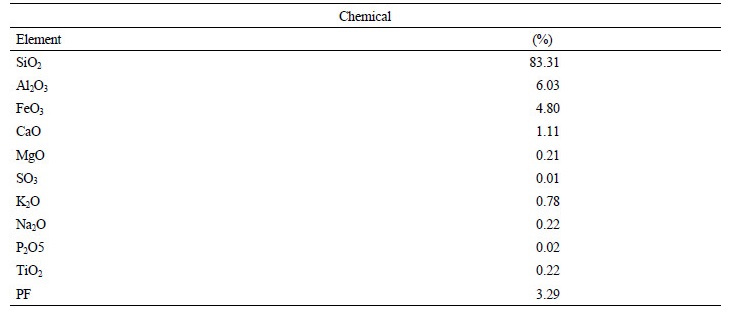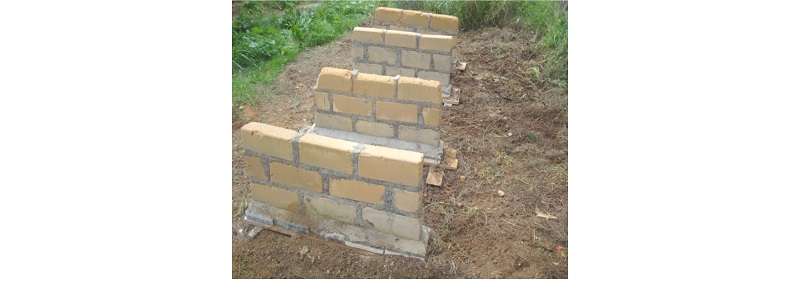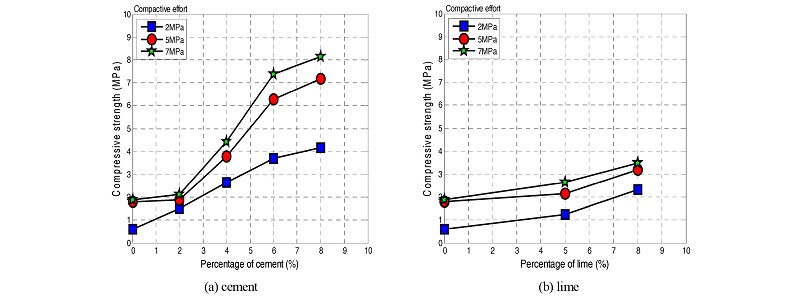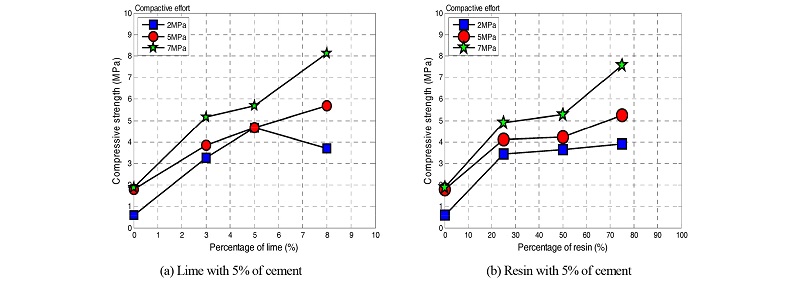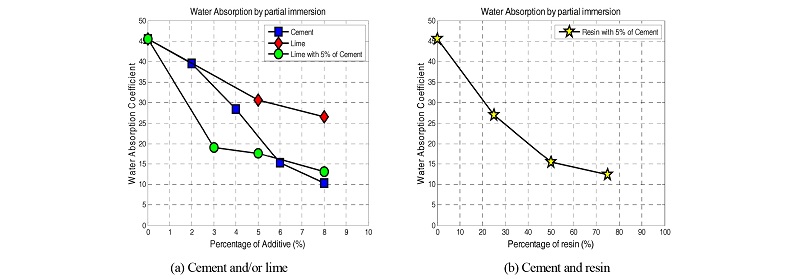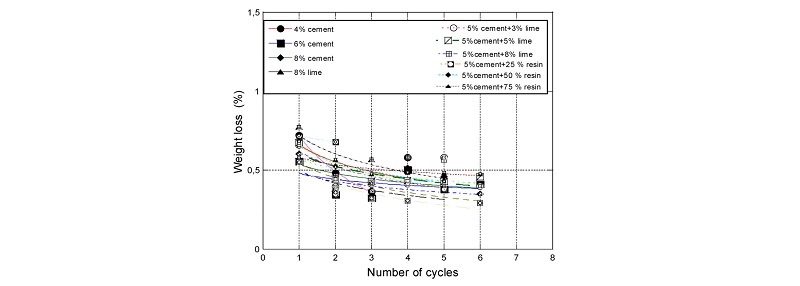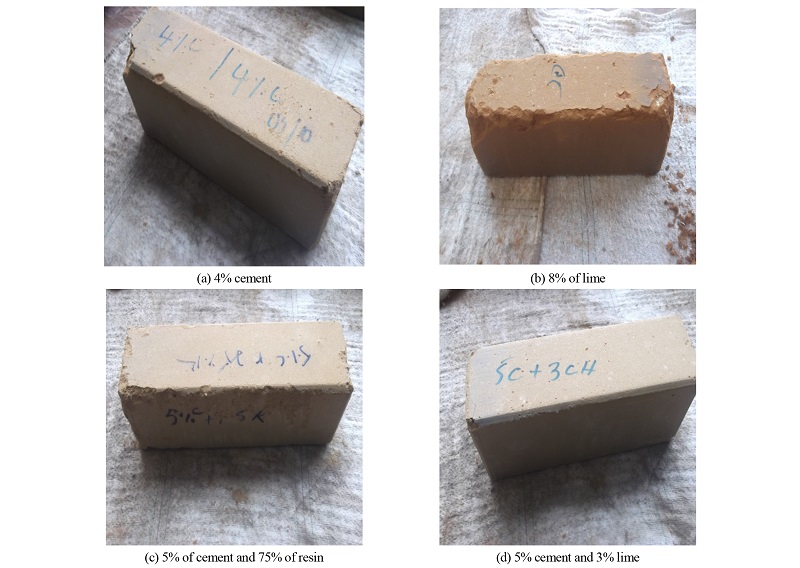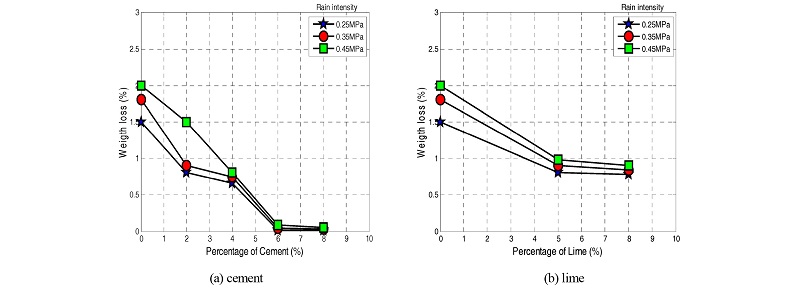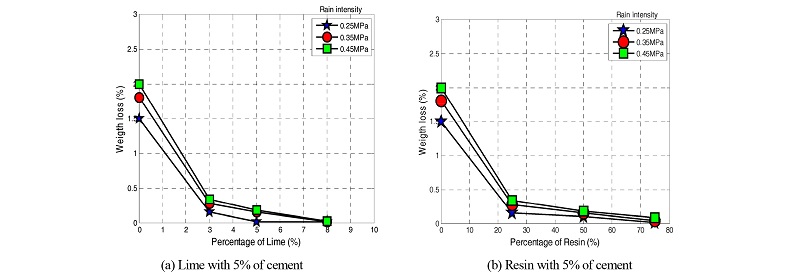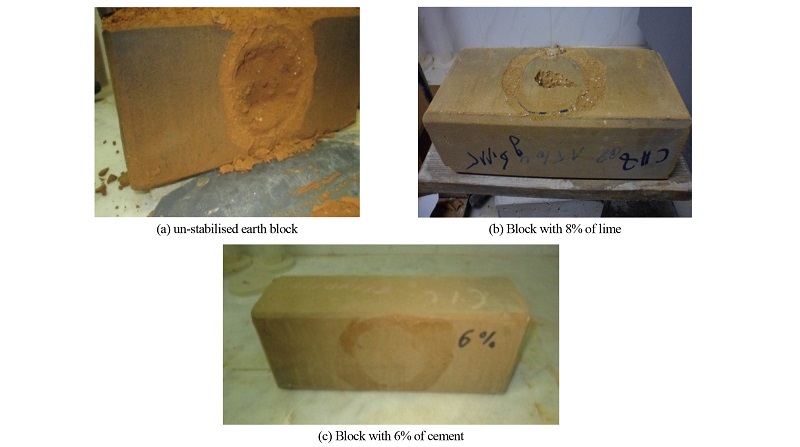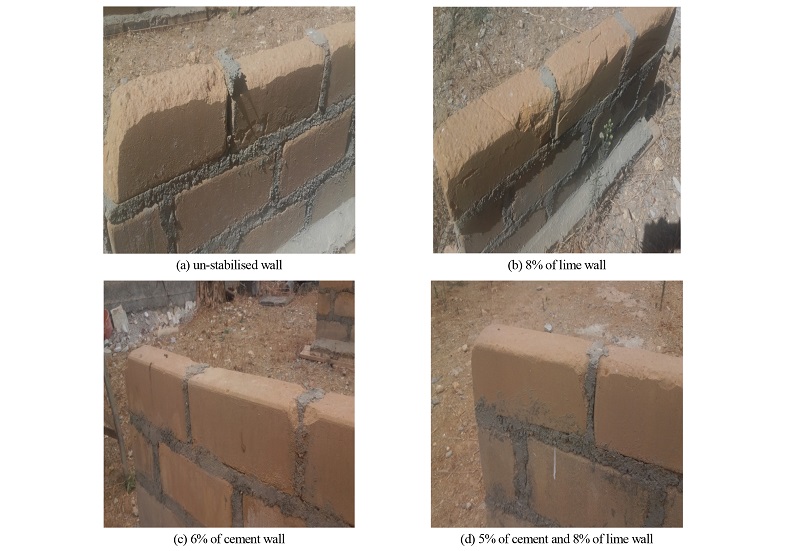Introduction
Materials and Test Methods
Soil Composition
Soil Stabilisation
Blocks and Wall Preparation
Testing Program
Compressive Strength
Capillarity
Wetting and Drying
Spray Test
Natural Ageing
Results and Discussions
Compressive Strength
Water Absorption
Wetting and Drying
Erosion Test
Durability
Conclusion
Introduction
Earth constructions are known to undergo a rapid deterioration under harsh weather conditions [1,2]. The mechanical, physical and chemical stabilisation is the mainly performed techniques to enhance the earth block durability and to limit the damage imputed to this drawback. Dynamic compaction and chemical stabilisation by cement considerably improve the mechanical performance of earth blocks [3]. In addition, the soil composition affects directly the stabilised earth blocks durability. As reported by Walker and Stace [4], effective control of the drying shrinkage depends on the clay percentage in the soil and the cement content used in the stabilisation process. Venkatarama and Gupta [5] pointed out the influence of high sandy soil on the improvement of mechanical properties of stabilised and compressed earth blocks. Three different contents were injected (6%, 8% and 12%); the results show the importance of the added cement amount on compressive strength, stress-strain and elastic property of the cured earth block. However, in order to avoid the friability of blocks and also for economic consideration, the cement amount is generally fixed between 5 to 10% [6]. The mechanical and hydrous properties of compressed earth blocks can be improved by lime [7]. More adapted for clayey soil, the lime imparts a long-term strength gain to earth blocks [8,9]. The use of admixture of lime and cement in earth stabilisation becomes economically a sustainable solution for large part of the population in the rural area. This combination has been studied by Bourroughs [10] in order to overcome the problems resulting from drying shrinkage. From their study, they confirmed the importance of the soil composition to enhance the compressed earth block performance. A new mixture with resin to stabilize the earth block was recently tested. The utilization of resin mixed with cement is used as a quick-setting agent. The compressive strength values of the earth blocks treated with 5% of cement and 50% of resin are upper than 17 MPa in a dry state [11]. However, varying the resin content to improve the mechanical and hydrous properties of the earth blocks have not been studied and reported.
Earth blocks construction durability under a climatic exposure becomes a major matter of concern. Nagaraj [12] investigated the role of the admixture of cement and lime to improve the long-term build up strength of the compressed earth blocks; the mutual benefit of cement and lime in imparting strength to the blocks is pointed out. The authors in Guettala et al. [11] examined the behaviour of walls in the weathering test. They discerned a large degradation of blocks prepared with 8% of lime after 48 months of exposure under the semi-arid climate (Biskra, Algeria), when no alteration has been observed in the upper surfaces of blocks prepared with 12% of lime. Furthermore, using a high content of lime reduces the rate of surface deterioration [13]. Kerali [14] carried out the study about the influence of cement on the durability of blocks under humid tropical environment. He underlined the need to investigate the involvement of parameters like drop size and drop size distribution on the mechanism of degradation.
The present work aims to investigate the benefits of classical additives such us cement and/or lime and the combination of cement with resin on mechanical and hydrous properties of earth blocks for different moulding pressures. The experiment consisting of the assessment of compressive strength, water absorption and performance at spray erosion test. In addition, much more interest is accorded to the evolution of the compressive strength and the water resistance of cement and resin earth blocks. The paper presents also the results of the natural ageing of walls exposed to the typical Mediterranean climate of Algiers (Algeria).
Materials and Test Methods
Soil Composition
The compressed earth blocks were prepared by using a soil with low content of clay as recommended by Houben et al. [15] and CNERIB [16]. The soil was subjected to several laboratory tests to determine the constituents. The chemical analysis has been accomplished by using Fluorescence X ray, in accordance to NF6 P 15-467 standard. The obtained results are shown in Table 1. The mineralogical analysis has been performed by using diffractometre (X-rays) and the results were directly collected from the computer. The mineral characteristics given in Table 2 illustrate a significant presence of quartz, where the clayey phase is represented by Illite and Kaolinite.
Soil Stabilisation
Stabilisation referred to any physical, chemical, biological, or combined method of alteration of soils to enhance their physical properties. Classical binders such as cement and lime at different percentage were added to stabilise the soil. In addition, mixtures of 5% of cement with increasing portion of lime and resin were also studied. The first stabiliser is an Ordinary Portland cement type CEM II 32.5. The cement is known to be well accommodated with low clayey and plastic soils as developed in CNERIB [17].
The other additives are ordinary commercial lime and a white resin named “MEDALATEX”. The aqueous dispersion of resin is compatible with mineral resources like cement and lime, ensures more impermeability to mortars and improves the resistance to chemical attacks. The percentage of the resin is a part of the optimum moisture content. The percentages of the additives are listed in Table 3.
The mechanical stabilisation is performed by a semi-automatic compressed earth brick machine. Three compactive efforts were applied throughout the experiment: 2, 5 and 7 MPa.
Blocks and Wall Preparation
Before mixing, the excavated soil was immediately dried under the sun, then crushed and finally passed through a 5 mm sieve to eliminate the large lumps. According to Houben et al. [15], the small elements of clay must be dissociated in order to avoid nodules, which affect considerably the compressive strength. The static compacting method selects the optimum moisture content in accordance with NF P94-093 standard [18] and local recom-men-dations [16]. This method provides a maximum dry density to the compressed earth block specimens.
The dimensions of the tested blocks are 295 mm of length (l), 140 mm of width (w) and 90 mm of height (h). The compaction of the blocks was achieved by using a hydraulic semi-automatic press.
After being demoulded, the compacted earth blocks prepared with different mixtures were left in air laboratory until the time of testing. The required testing age for earth/cement blocks is 28 days when 90 days are necessary for earth/lime mixture [19].
The dimensions of the walls are 0.5 m height and 1 m length. The earth with cement mortar was used as wall joints. The exposure concerns the test of eight different walling unit's with the following combinations of additives: 0% of additive (un-stabilised block) as a benchmark, 4%, 6% and 8% of cement, 8% of lime, 5% of cement with 5% and 8% of lime and finally 5% of cement with 75% of resin. In order to evaluate the direct effect of rainfall, no roofing or hat was covering the walls top.
Testing Program
Compressive Strength
The compressive strength test has been performed with electromechanical press MTS Corporation System machine with a capacity of 300 kN (Figure 1). The test consists of applying an escalating compressive load until failure. The machine is equipped with Test-Suit software for programming loads and indicating the frequency of acquisition. The direction of the stress is in the longitudinal axis of the sample. A regular load velocity around 1.2 mm/min was chosen for the experiment. Three samples were tested to assess the block compressive strength.
Capillarity
Water absorption test consists of determining the water content absorbed by capillarity in compressed earth block. Before being immerged, the sample was weighed with a precision of 2 g; afterwards the lower face of the specimen was immerged in a water bath at a depth of 5 mm and left for 10 min. The test was performed with six entire blocks in accordance with XP P13-901 standard [20]. The water absorption coefficient Cb relates the assessment of water absorption as given by Eq. (1).
where: M: Absorbed water weight during the test (g); S: Immerged area (cm2); t: Immersion time (min).
A second part of the experiment consisted of immersing totally the specimen into the water for 7 days. In this case, the weight loss is representing the effect of additives.
Wetting and Drying
Besides, a wetting/drying durability test was also performed in laboratory. In accordance with ASTM D559-57 standard, the procedure consists of immersing the earth blocks in water during 5 hours, then put in an oven to dry at a temperature of 71°C for 42 hours. Afterwards, the samples were brushed to remove the soil fragment affected by wetting and drying cycle (48 hours). This procedure is repeated six times. The variation of weight is calculated after each cycle using the following Eq. (2).
Where: Pi: The block weight after the ith cycle (g); Pi+1: The block weight after the (i+1)th cycle (g).
Spray Test
The accelerated erosion test concerns only the 7 MPa forming pressure blocks. This test was performed by sub-jecting the blocks to water spray for 2 hours at a distance of 0.17 m. Commonly known as spray erosion test, authors consider this experiment as a more direct replication of rainfall borne erosion [21]. The exposed surface is a circle with 100 mm of diameter. The block is attached inside two wooden plaques through which a Polyvinyl chloride joint is incorporated to avoid water infiltration. The system is fixed with two metallic stems in order to keep the initial position.
Three different water pressures were exerted on earth blocks: 0.250 MPa, 0.350 MPa and 0.450 MPa. The impact of the erosion is estimated by the weight losses and the maximum depths of the hole provoked on the surface of the exposed block. The Figure 2 shows the test carried out in the laboratory.
Natural Ageing
This test setup consists of the exposure of eight walls in real climatic conditions for 24 months. The exposure area is in the South-West of Algiers (Algeria). The data provided by the Meteorology National Agency for the last 30 years are typical of Mediterranean climate, which is hot and dry in summer, cold and humid in winter. The relative mean humidity is around 70% with a minimum value of 25% in April 2014 and a maximum value of 90% in January. The weather precipitation is around 850 mm/year with only one day/year of hail. During the exposure, the extreme temperature varied between 38.6°C and 6.3°C, recorded respectively in July and January 2015. The maximum wind velocity attained 77 Km/h. Periodical visits and visual inspections were programmed each two months. The diagnostic concerns the detection of defects such us, surface roughening, surface pitting, cracking and surface erosion.
Results and Discussions
Compressive Strength
As shown in Figures 4 and 5, the compressive strength values of earth blocks are increased by rising the different additive contents. The stabilisation imparts to the blocks a compressive strength gain ratio ranging from 2 to 6. The enhancement of the earth/cement blocks resistances are more marked compared to the earth/lime blocks. In the range of cement content from 2% to 6%, the compressive strength is subjected to pronounced increase. The increase of the CSEB compressive strength is relied on the reactions occurred during the curing process. For a stabilisation by cement, the strength gain is obtained after the hydration phase of the cement. The mixture of the cement paste, sand and soil particles (<5 mm) is considered as particular concrete. The cement grains are dissolved in a mixture of water sand, and soil releasing calcium and silicon ions in the process. Once the ions spread throughout the mixture and reach a critical concentration in solution, they begin to precipitate out of solution and form a cement film around the small soil particles. In return, the variation of the compressive strength of lime-stabilised blocks did not exceed 2 MPa along the stabiliser content interval (Figure 4b). The compressive strength values of earth/lime blocks are still less than those indicated in Lunt [22] notes or CNERIB recommendations [16] (6 MPa and 5 MPa in dry state respectively). The lime is expected to impart less compressive strength to the earth blocks compared to cement. It is commonly known that the lime reacts readily with expanding clays. In this work, the kaolinite or elements within their crystal lattices react with lime to produce cementing materials and after compaction slowly gain pozzolanic strength. However, the proportion of the kaolinite (10%) offers a closed reaction area.
Fixing the cement content to 5% in the case of mixed combinations provides more resistance to the earth blocks. The evolutions of the compressive strength of cement/lime and cement/resin earth blocks are similarly charac-terized by a substantial increase of the block resistance values as the contents of lime and resin are respectively equal or exceed 5% and 50% (Figure 5a, b). In this case, the compressive strength values approach the limit value fixed by the CNERIB recommendation [16].
An ascending trend of the compressive strength of earth blocks is observed with the increase of the compactive effort. Furthermore, the influence of the blocks compaction energy on compressive strength values is more signi-ficant as the stabiliser contents are gradually added. For instance, as the cement content is increased from 2% to 8%, the compressive strength gain between these two highly compressed (7 MPa) blocks exceeds 6 MPa. In contrast, this difference is much smaller as the compactive effort is reduced. However, this finding does not emerge from the evolution of the compressive strength of the earth/lime stabilised blocks as previously pointed out by Heathcote [23]. The author mentioned three main factors to control the block strength: clay quantity in the soil, cement con-tent and density of the compacted soil. The evolution of the resistance of the earth blocks treated with mixed addi-tives shows a similar trend with earth/cement blocks compressive strength values. For the cement and lime stabili-sation, the compressive strength jumps considerably as the compactive effort rises to 7 MPa. This outcome con-firms the conclusion of Guettala et al. [11], with 8% of lime and 4% of cement they recorded 15.6 MPa of compressive strength for 15 MPa of compacting stress.
Water Absorption
The results of the water absorption in partial immersion test versus additive contents are depicted in Figure 6. The stabilisation of earth blocks by adding and increasing the additive portion reduces drastically the water absorption rate. Furthermore, the stabilised earth blocks including the mixed combinations with at least 5% of cement are the less affected by the capillarity effect. Indeed, the cement induces less surface porosity in the blocks in comparison to un-stabilised earth ones. These results are concordant with those reported by Venkatarama [5] where they observed a decrease of the water absorptions as the cement content in the blocks rises gradually from 6% to 12%. As can be expected for high sandy soil, the water absorption rate of the earth/lime mixes becomes more important (Figure 6a). The lime reacts only with clayey phases and the pores dimensions are directly linked to the compactive effort. The water absorption coefficient (Cb) value is around 26.56 for 8% adding content, whereas mixing cement and lime reduces the capillarity effect. For instance, the combination of 5% of cement and 8% of lime decreases the absorbed water amount (Cb=11.6). This result is due to the presence of cemented earth particles, which fill the pores of the blocks and impede the flocculation of particles contained in the soil. The role of the lime is to fix the calcium hydroxide present in hydrated cement paste. This process avoids the development of cracks and pores widening. The results are in accordance with the outcomes reported by Guettala et al. [11], the enhancement of water resis-tance of the blocks coincides with increasing lime content and compactive efforts. The use of resin mixed with cement also diminishes the water absorption rate in comparison with non-cured earth blocks (Figure 6b). Indeed, for a high content of resin, the water absorption coefficient is less than 15. The chief function of resins is to maintain the moisture content of a soil at or below optimum moisture by preventing entry of water into the treated and compacted mixture.
The evolution of the water absorption values as function of additives is in correlation with the weight loss results after the total immersion test (7 days). As shown in Figure 9, the weight loss is drastically reduced by increasing the additives content. In addition, as stated for the capillarity effect, the loss of mass affects severely the earth blocks treated with lime.
Wetting and Drying
The results show that the loss in weight decreases when increasing the stabiliser contents (Figure 8). In addition, the block friability is observed on earth/lime surfaces. For instance, the accumulated weight loss represents 2.79% of the earth/lime block mass after 5 cycles. In return, after 6 cycles this mass loss is limited to 2.51% when using 6% of cement. The chemical stabilisation produced by lime interact only with clayey phases. The proportion of the minerals representing the clayey phases (Kaolinite+illite) is less than 15%. Therefore, the resistance of the blocks against the weeting/dry test is largely conferred by the mechanical stabilisation. The blocks treated with the admix-ture of cement/lime and cement/resin are also affected by an irrecoverable loss of mass with respectively a maxi-mum accumulated weight loss of 2.87% and 3.17%. This finding confirms the conclusions made by Guettala et al. (2006). From their studies, the weight loss value observed on blocks treated with 5% of cement approaches 1.4% in com-parison with the 2.3% for those stabilised with the mixture of cement/resin and cement/lime. As shown in Figure 9, the wetting and drying test appears very severe. The surface alteration including surface pitting and chipped edges and corners are the main defects. Initially predestined to evaluate the strength of core concrete, this test could be adapted to estimate the water resistance of the stabilised earth blocks by reducing the number of cycles.
Erosion Test
The accelerated erosion test results show that the blocks weight-loss follows a downward trend with the increase of the percentage of additives (Figures 10 and 11). The blocks prepared with earth/cement mixes are the less affec-ted by the surface erosion. This evolution of the weight loss is well correlated with the measurement of the maxi-mum depth of the hole (Figure 12). The blocks containing 6 and 8% of cement fulfil the guidelines recommendation indicated in the Uniform Building Code [22] with a depth of the hole inferior to 1.5 mm. The earth/lime blocks are prone for damage under spray erosion test due to low compressive strength; the maximum depth approaches 38 mm as shown in Figure 12b. However, this surface degradation is largely controlled with the admixture of cement and lime. Furthermore, this trend is also observed when the combination of cement and resin is performed, the weight loss decreases significantly as the content of resin became important as shown in Figure 11b. The perfor-mance of the reinforced soil blocks can be explained by the resin ability to bind the soil particles from been washed away, the-reby reducing the eroding effect on the blocks. The present investigation fully corroborates the outcomes of Falceto et al. [25], where no surface degradation in blocks prepared with 6% of cement and 8% of cement-quick-lime has been observed. Similarly, Ola and MBata [26] pointed out that with a preparation of block with 5% of cement and 8 MPa of compactive effort a better withstanding against surface erosion was noticed. Thus, the performance of the CSEB against the accelerated erosion test depends on the nature and proportion of the stabilizer and the compactive effort. The extrapolation of mechanical properties and durability by the test spray is possible. Block compressive strength results for different stabilizations can be positively correlated with spray test durability results.
Durability
The results of walls exposure to weather conditions are outlined in Figure 13. The walls built with no additives or with low portion of stabilisers in blocks undergo severe damages. The alterations included: surface roughening, surface pitting, cracking and irrecoverable loss of mass “erosion”. The prospection of the wall with block unit treated with 8% of lime reveals that the defects included surface erosion and cracking. A maximum depth of 2 cm was noticed in the chipped edges after only 12 months of exposure and the damage affects 60% of the upper surface of the wall (Figure 13b). The location of the cracking is mainly in the middle parts of the blocks and the erosion involves largely the corners. Differential erosion appears in the front of these walls; it indicates that the alteration does not proceed at the same rate from one area of the block to the other. Guettela et al. [11] confirmed this noticing after exposing walls with block units treated with 8% of lime for 48 months. They announced that for only 120 mm/year of preci-pitation, the damage reaches 40% of the upper surface. Meanwhile, the wall constructed with block treated with 12% of lime showed no signs of erosion.
After 24 months, the wall with block units treated with 6% of cement represents no sign of erosion, but a small fragment of the bricks disappears from the first line (Figure 13c). In addition, no loss of components or presence of rounding is observed. During the winter, an indication of efflorescence was noticed. The upper surface of the wall built with blocks containing 8% of cement indicates no sign of deterioration but a small surface roughening. This trend concerns also the surfaces in the top of the walls with block units prepared with the mixed additives. The surface of block stabilised with 5% of cement and 8% of lime (Figure 13d) with those treated with 5% of cement and 75% of resin show less degradation compared to walls constructed with un-stabilised or lime stabilised blocks. The erosion represents respectively 6% and 2% of wall thicknesses. However, under a humid tropical zone, Kerali [14] examined the state of blocks treated with 5% of cement during 8 and 12 years. The loss in volume from unroo-fed and unrendered blocks over a period of 12 years attains 38%. He affirmed also the importance to inves-tigate the impact of parameters like drop size, drop size distribution, fall velocity and kinetic energy on blocks degradation.
The results of natural ageing test confirm the inter-correlation between the test conditions in laboratory and the real exposure of blocks. The degradations provoked by the natural ageing are less prominent compared to those caused by the test carried out in laboratory. The weight loss corresponding to spray erosion test approaches the results observed on the real exposure. Heathcote et al. [27] confirmed this outcome by testing a series of blocks treated with 3% to 8% of cement. The first group exposed to weather condition and the second subjected to the pulverization test in laboratory. The results reveal a correlation of weight losses between the samples tested in laboratory and those under natural ageing.
Conclusion
This paper reports on recent investigation of the impact of stabilisation on mechanical and hydrous properties of earth blocks. The experimental campaign was undertaken to assess the compressive strength, the water resistance and the durability of cement and/or lime and cement/resin earth blocks. The studied parameters are the percentage of additives and the compactive effort. For a high sandy soil, low compressive strength and severe damage under weather exposure such as crumbling and hollow indentation affects the block treated with lime. In return, the block resistance increases substantially as the cement content rises. Conjointly, a similar trend with earth-cement block resistance emerges when the tests of cement/lime and cement/resin earth blocks were achieved.
․The paper points out the importance of the energy of compaction. Increasing the compactive effort improves the blocks resistance and limits the degradation of blocks under spray erosion test. Thus, the compressed earth block resistance depends on the soil characteristics, the type/content of additive and the compactive effort.
․The utilization of cement mixed with a high content of resin (75%) decreases severely the water absorption by capillarity. In addition, the blocks resistance at destructive test and under the rainfall simulation pressure was increased. The hydrous properties of earth blocks are strongly influenced by the combination of cement and lime with 7 MPa of compactive effort. The effect concerns the limitation of the total mass reduction of the blocks under the aggressive accelerated erosion test.
․The stabilisation of earth blocks improves considerably the durability of the walls. The results of natural ageing test reveal that the walls constructed with the relevant additive composition got negligible degradation after exposure in real climatic conditions. It confirms also the harshness of the test laboratory conditions. The ade-quate performance of stabilised wall in this work depends on three factors: choosing the right constituent mate-rials, using the correct processing methods and counteracting properly the effects of the exposure environment. In future work, a unique valuation of the state of concerned housing in North Africa will be conducted in order to bring out the impact of long time exposure.



